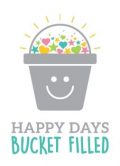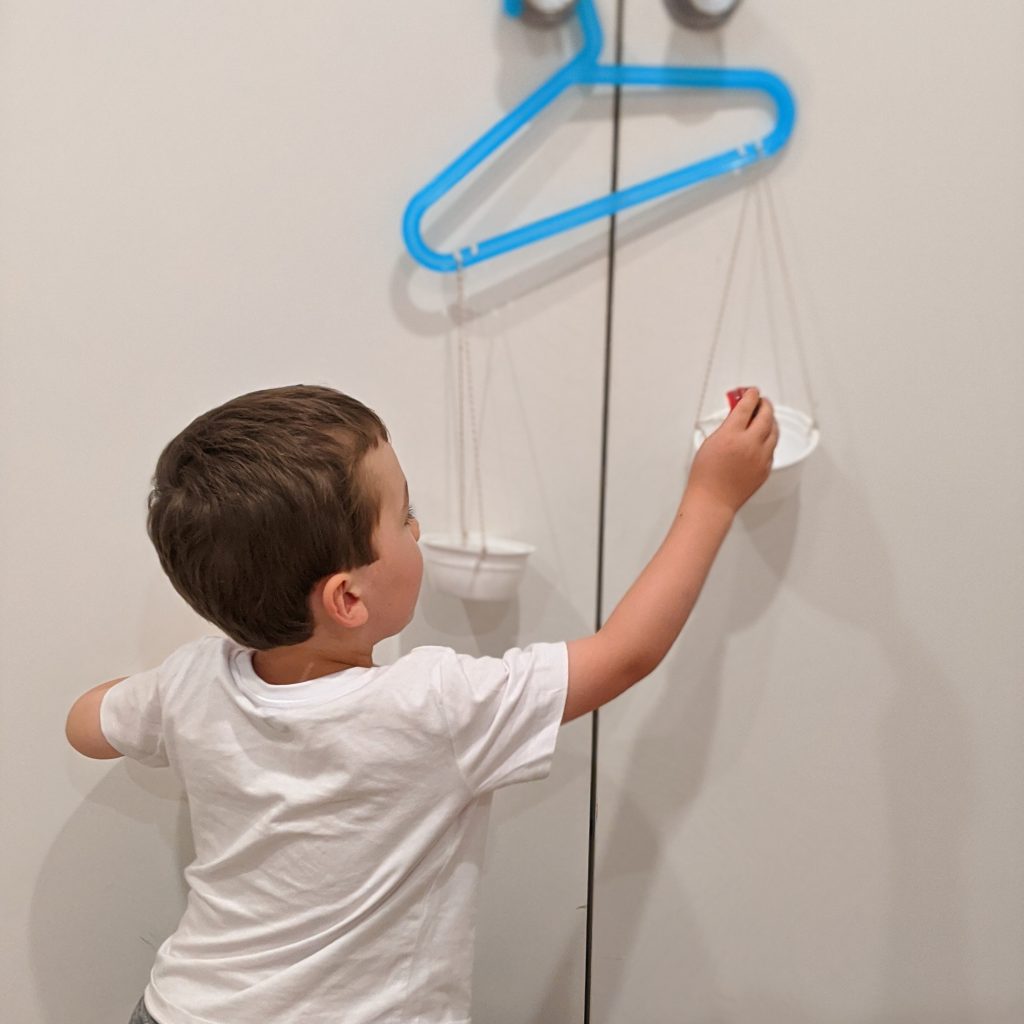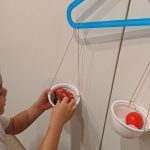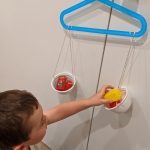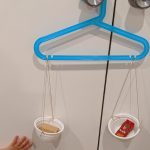- 10 - 20 mins
- Measurement, investigation, prediction, sorting, testing
- Minimal mess
- Easy!
This DIY hanging scale is an easy, inexpensive, and simple activity to explore learning in weight comparison and measurement terminology such as “bigger”, “heavier”, “smaller”, “lighter”, “greater than”.
Your child will use a hands-on approach to investigate, predict, test and sort objects by weight. It is through this activity that children will begin to discover the relationship between the weight of one object and how it relates to another and further, begin to understand simple and basic measurement techniques and concepts.
Did you know? Helping children to understand measurement is an important skill to learn for everyday life, but also helps to assist with other areas of mathematics. Learning measurement will help children understand number skills and spatial concepts.
What you will need
- Plastic coat hanger
- String
- 2x containers (rice bowls or similar)
- A range of testing objects- e.g. toy cars, peg, rocks, blocks wooden people
Activity steps
Set up:
- Find a suitable place to hang your coat hanger. You should aim to find somewhere that is at a good height for your child to reach, but high enough so that it is suspended in the air. We used our closet door handle. Alternatively, you could hang from a nail in the wall, the back of a chair, a kitchen draw handle)
- Using your scissors, make a small hole in one side of one of your containers. And then repeat this to the other side of the container. Your two holes should be opposite one another.
- Repeat step 2 and do the same to your second container.
- Now using your scissors cut two equal lengths of string. Make your string long enough so that it can be attached to either side of your container and be hung over the coat hanger. About 60 cm each should be fine.
- Take one length of cut string and thread it through one hole on your container and tie it securely. Then take the end of the string and thread it through the opposite hole and tie it off.
- Repeat step 5 to the other container.
- Hang your containers on the coat hanger. One container on one side and the other on the opposite. Hang it in the groove part so they don’t slip off or alternatively use a clip hanger and clip the containers to either side. Make sure your containers are hanging even and flat.
- Gather some household items to weigh and put it next to the scale. Items your child is familiar with and that are not super heavy are ideal. For example, toy cars, duplo, little wooden blocks, little people, pegs, rocks etc).
Now you’re ready to investigate!
How to play:
- Allow your child some time to observe, play and tinker with the DIY scale. Let them explore how it works, for younger children you may need to facilitate this.
- Now, encourage your child to choose an item and place it in one side of the scale. Then ask them to choose a second item and place it in the other side.
- Ask your children to tell you what they notice. Did they notice that the scale moved? Why might that happen? This would be a good opportunity to introduce and discuss the terms “heavy” and “light”.
- Now ask them to compare the two objects, which one is heaviest, and which is lightest? You could use this opportunity to ponder why that might be the case. For example, the rock is bigger than the peg. OR The peg is made of plastic and the toy car is made of metal.
- Once you have determined which is heaviest and lightest, encourage your child to repeat the process and try some different objects. Once the understand how to play you could ask them to hypotheses- which item do they think will be heavier? They might also like to start comparing multiple objects at once. For example. One peg, and one car vs one big rock… Which is heaviest?
The results of this activity will depend on your child and their understandings. I would suggest starting simple with basic weight terminology such as heavy and light, before extending upon terms such as “greater than” etc. Have fun and let us know how it went for you n the comments below.
Extension ideas:
- Using two plastic plates, label one “Light” and one “Heavy”. Weight two items and then decide which is heavy and which is light and place it on the corresponding plate. Once you have a full plate of objects perhaps you could compare all of the heavy items to determine the heaviest and do the same for the light objects
- Try a variety of objects- perhaps you could encourage your child to find their own objects to compare.
Learning Outcomes
- Understanding of measurement
- Sorting & categorisation skills
- Foundational science skills- investigation, testing, prediction, discovery
Reference sites
We would like to acknowledge these amazing sites that have inspired us to create this activity. Thank you!
